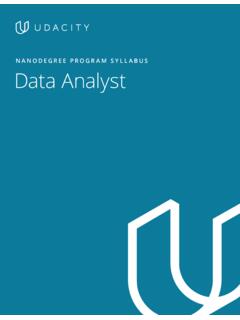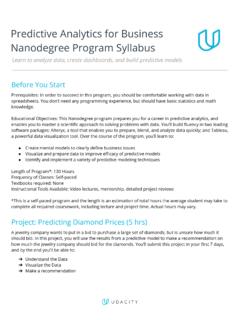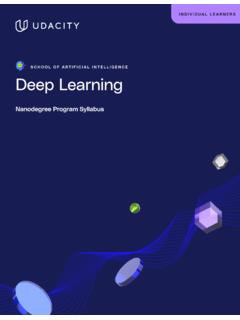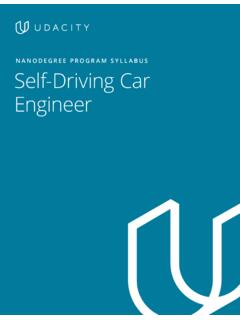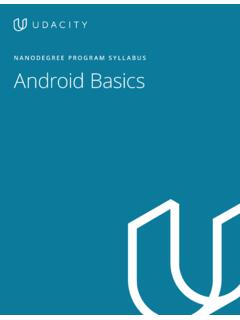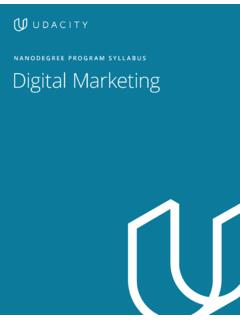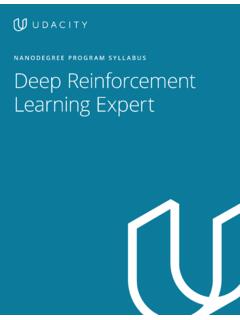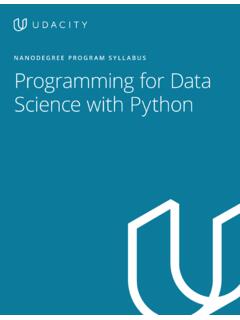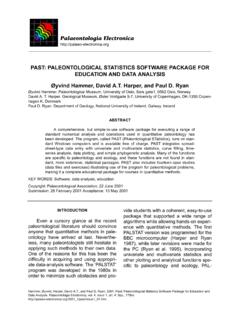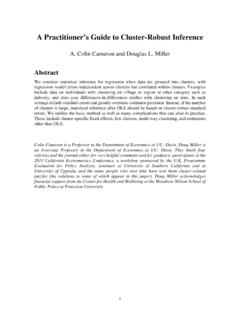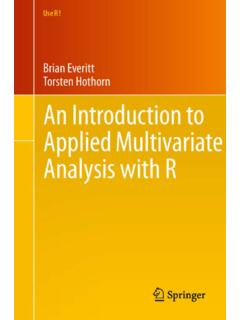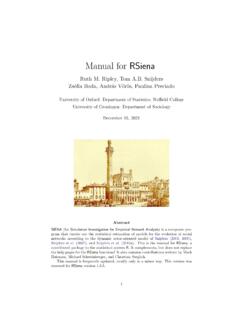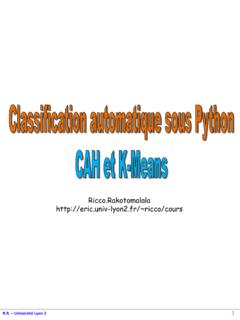Transcription of NANODEGREE PROGRAM SYLLABUS Data Scientist
1 NANODEGREE PROGR AM SYLL ABUS. Data Scientist Need Help? Speak with an Advisor: Overview The Data Scientist NANODEGREE PROGRAM is an advanced PROGRAM designed to prepare you for data Scientist jobs. As such, you should have a high comfort level with a variety of topics before starting the PROGRAM . In order to successfully complete this PROGRAM , we strongly recommend that the following prerequisites are fulfilled. If you do not have the necessary prerequisites, Udacity has courses and programs that prepare you for this NANODEGREE PROGRAM . Programming: Python Programming: Writing functions, logic, control flow, and building basic applications, as well as common data analysis libraries like NumPy and pandas SQL programming: Querying databases using joins, aggregations, and subqueries Comfortable with using the Terminal, version control in Git, and using GitHub Probability and Statistics: Descriptive Statistics: Calculating measures of center and spread, estimation distributions Inferential Statistics: Sampling distributions, hypothesis testing Probability: Probability theory, conditional probability Mathematics: Calculus: Maximizing and minimizing algebraic equations Linear Algebra: Matrix manipulation and multiplication Data wrangling.
2 Accessing database, CSV, and JSON data Data cleaning and transformations using pandas and Sklearn Data visualization with matplotlib: Exploratory data analysis and visualization Explanatory data visualizations and dashboards Machine Learning: Feature Engineering Supervised Learning: Regression, classification, decision trees, random forest Unsupervised Learning: PCA, clustering The following programs can prepare you to take this NANODEGREE PROGRAM . There are also several free courses that you can use to prepare. Programming for Data Science with Python. Data Analyst NANODEGREE PROGRAM . Intro to Machine Learning NANODEGREE PROGRAM Educational Objectives: The ultimate goal of the Data Scientist NANODEGREE PROGRAM is for you to learn the skills you need to perform well as a data Scientist .
3 As a graduate of this PROGRAM , you will be able to: Use Python and SQL to access and analyze data from several different data sources. Need Help? Speak with an Advisor: Data Scientist | 2. Overview Use principles of statistics and probability to design and execute A/B tests and recommendation engines to assist businesses in making data-automated Deploy a data science solution to a basic flask app. Manipulate and analyze distributed datasets using Apache Spark. Communicate results effectively to stakeholders. I N CO L L A B O R AT I O N W I T H. Estimated Time: Prerequisites: 4 Months at Python, SQL &. 10hrs/week Statistics Flexible Learning: Need Help? Self-paced, so you can learn on Discuss this PROGRAM the schedule that with an enrollment works best for you advisor.
4 Need Help? Speak with an Advisor: Data Scientist | 3. Course 1: Solving Data Science Problems Learn the data science process, including how to build effective data visualizations, and how to communicate with various stakeholders. In this project, you will choose a dataset, identify three questions, Course Project and analyze the data to find answers to these questions. You will create a GitHub repository with your project, and write a blog post Write a Data Science to communicate your findings to the appropriate audience. This Blog Post project will help you reinforce and extend your knowledge of machine learning, data visualization, and communication LEARNING OUTCOMES. Apply the CRISP-DM process to business applications Wrangle, explore, and analyze a dataset Apply machine learning for prediction The Data Science LESSON ONE Apply statistics for descriptive and inferential Process understanding Draw conclusions that motivate others to act on your results Implement best practices in sharing your code and written summaries Communicating with LESSON TWO Learn what makes a great data science blog Stakeholders Learn how to create your ideas with the data science community Need Help?
5 Speak with an Advisor: Data Scientist | 4. Course 2: Software Engineering for Data Scientists Develop software engineering skills that are essential for data scientists, such as creating unit tests and building classes. LEARNING OUTCOMES. Write clean, modular, and well-documented code Refactor code for efficiency Software Engineering Create unit tests to test programs LESSON ONE. Practices Write useful programs in multiple scripts Track actions and results of processes with logging Conduct and receive code reviews Understand when to use object oriented programming Build and use classes Understand magic methods Object Oriented Write programs that include multiple classes, and follow LESSON TWO. Programming good code structure Learn how large, modular Python packages, such as pandas and scikit-learn, use object oriented programming Portfolio Exercise: Build your own Python package Learn about the components of a web app Build a web application that uses Flask, Plotly, and the LESSON THREE Web Development Bootstrap framework Portfolio Exercise: Build a data dashboard using a dataset of your choice and deploy it to a web application Need Help?
6 Speak with an Advisor: Data Scientist | 5. Course 3: Data Engineering for Data Scientists Learn to work with data through the entire data science process, from running pipelines, transforming data, building models, and deploying solutions to the cloud. Figure Eight (formerly Crowdflower) crowdsourced the tagging and Course Project translation of messages to apply artificial intelligence to disaster Build Disaster Response response relief. In this project, you'll build a data pipeline to prepare Pipelines with Figure the message data from major natural disasters around the world. You'll build a machine learning pipeline to categorize emergency text Eight messages based on the need communicated by the sender. LEARNING OUTCOMES. Understand what ETL pipelines are Access and combine data from CSV, JSON, logs, APIs, and databases Standardize encodings and columns LESSON ONE ETL Pipelines Normalize data and create dummy variables Handle outliers, missing values, and duplicated data Engineer new features by running calculations Build a SQLite database to store cleaned data Prepare text data for analysis with tokenization, lemmatization.
7 And removing stop words Use scikit-learn to transform and vectorize text data Natural Language LESSON TWO Build features with bag of words and tf-idf Processing Extract features with tools such as named entity recognition and part of speech tagging Build an NLP model to perform sentiment analysis Understand the advantages of using machine learning pipelines to streamline the data preparation and modeling process Chain data transformations and an estimator with scikit- learn's Pipeline Machine Learning Use feature unions to perform steps in parallel and create LESSON THREE. Pipelines more complex workflows Grid search over pipeline to optimize parameters for entire workflow Complete a case study to build a full machine learning pipeline that prepares data and creates a model for a dataset Need Help?
8 Speak with an Advisor: Data Scientist | 6. Course 4: Experiment Design and Recommendations Learn to design experiments and analyze A/B test results. Explore approaches for building recommendation systems. Course Project IBM has an online data science community where members can post tutorials, notebooks, articles, and datasets. In this project, you will Design a build a recommendation engine, based on user behavior and social Recommendation Engine network in IBM Watson Studio's data platform, to surface content with IBM most likely to be relevant to a user. LEARNING OUTCOMES. Understand how to set up an experiment, and the ideas associated with experiments vs. observational studies LESSON ONE Experiment Design Defining control and test conditions Choosing control and testing groups Applications of statistics in the real world Statistical Concerns Establishing key metrics LESSON TWO.
9 Of Experimentation SMART experiments: Specific, Measurable, Actionable, Realistic, Timely How it works and its limitations Sources of Bias: Novelty and Recency Effects Multiple Comparison Techniques (FDR, Bonferroni, Tukey). LESSON THREE A/B Testing Portfolio Exercise: Using a technical screener from Starbucks to analyze the results of an experiment and write up your findings Need Help? Speak with an Advisor: Data Scientist | 7. Distinguish between common techniques for creating recommendation engines including knowledge based, Introduction to content based, and collaborative filtering based methods. LESSON FOUR Recommendation Implement each of these techniques in python. Engines List business goals associated with recommendation engines, and be able to recognize which of these goals are most easily met with existing recommendation techniques.
10 Understand the pitfalls of traditional methods and pitfalls of measuring the influence of recommendation engines under traditional regression and classification techniques. Create recommendation engines using matrix factorization Matrix and FunkSVD. LESSON FIVE Factorization for Interpret the results of matrix factorization to better Recommendations understand latent features of customer data Determine common pitfalls of recommendation engines like the cold start problem and difficulties associated with usual tactics for assessing the effectiveness of recommendation engines using usual techniques, and potential solutions. Need Help? Speak with an Advisor: Data Scientist | 8. Course 5: Data Science Projects Leverage what you've learned throughout the PROGRAM to build your own open-ended Data Science project.
